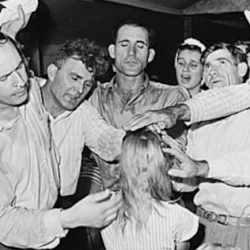Back in 1960, less that 15% of the population of the US was non-European. Most of that minority were blacks. That proportion has more than doubled in the fifty years since: “the growth of non- Europeans is expected to continue at an accelerated rate. In just the last twenty years (1980 to 2000), while the non-Hispanic white population grew about 8 percent, the growth rate of other groups is far larger. During the same period (1980 to 2000), the African American population grew by nearly 30 percent, the Native American population by 75 percent, the Latino population by 142 percent, and Asian American population by 185 percent. In absolute numbers, the United States has well over 35 million more people of color in 2000 than it did in 1980. This is more people than lived in the entire United States during the Civil War period of the early 1860s” (United by Faith, 1).
Yet, most American churches – more than 90%, according to the authors of this book – remain uniracial (defined by the authors as a church whose membership is 80% or more from a single race): “just 7.5 percent of the over 300,000 religious congregations in the United States are racially mixed. For Christian congregations, which form over 90 percent of congregations in the United States, the percentage that are racially mixed drops to five and a half. Of this small percentage, approximately half of the congregations are mixed only temporarily, during the time they are in transition from one group to another” (2). They observe, “The racial division of congregations has become a defining characteristic of the Christian faith in the United States” (182).
They city Michael Emerson’s conclusion in Divided by Faith that, far from being a solution to racial segregation, the American creed of individualism is part of the problem. They summarize the “fundamental creed of the United States of America” as the belief that “individuals are endowed with rights and freedoms and that there should be liberty and justice for all,” and add: “At least in its current interpretation, it simply declares that within limits, people should be free to do as they wish and not restrict other people from doing the same. Divided by Faith showed the ways and reasons that this creed has led to numerous religious affiliations in the United States, resulting in about 90 percent of worshipers attending racially homogeneous congregations. When religious people make choices based on their individual rights, they largely end up in homogeneous congregations” (4).
First a criticism, and then, with Niebuhr lurking in the background, two observations. The criticism: The authors make use of a questionable understanding of “race,” one with a specifically American origin (for background, see C. Loring Brace, “Race” Is A Four-Letter Word, valuable and detailed though not convincing in some of its central claims). If a congregation includes people of German, Polish, Irish, and English origin, it is an “inter-racial” church by some definitions. It certainly is inter-racial by comparison to 19th-century churches. Their book would have been strengthened if they had probed the meaning of the central concept of “race.”
Still, the authors highlight a genuine problem in American Christianity, and that leads to two observations. First, despite some improvements, the segregation of American Christianity that Niebuhr highlighted continues. Second, it continues because American individualism and voluntarism trump the gospel’s call to reconciliation among peoples and nations.














